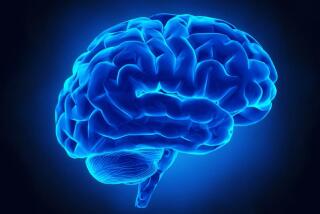Science File / An exploration of issues and trends affecting science, medicine and the environment. : Hunting a Brain Invader : Scientists are tracking an elusive virus that some suspect may help trigger schizophrenia.
- Share via
The rats in Dr. Ian Lipkin’s UC Irvine laboratory are severely disturbed.
Some sit statue-like, withdrawn into a private mental landscape. Others chase their tails round and round, gnawing them into shreds. A few are sedentary and massively obese; others masturbate continuously.
These activities correspond roughly to symptoms of schizophrenia in humans, researchers say. And indeed, when the rats are treated with anti-schizophrenia drugs, their symptoms disappear and they begin to behave like normal laboratory rats.
The rats are not products of broken homes, their mothers did not abuse them when they were young, and there was no emotional trauma in their early lives.
Instead, they were infected with a common virus called Borna disease virus, or BDV. The virus invades their brains, killing some brain cells and blocking the transmission of messages between others.
Researchers have long known that the virus can cause symptoms of severe mental illness in many animals, but the relevance of those observations to humans has been hotly disputed. The virus was thought to be constrained to pockets in Europe, and because it had never been shown to infect humans it was not a good candidate as a cause of mental illness.
Recently, the situation has changed dramatically. Using new genetic engineering techniques, researchers have detected the virus around the world. “Everywhere anybody is looking, this virus is showing up,” said Dr. Royce Waltrip II of the Maryland Psychiatric Research Center.
Over the last 10 years, furthermore, researchers have isolated the virus antibodies from psychiatric patients in Europe and the United States--strong, but not convincing, evidence that the virus attacks humans.
Now researchers have gone one step further. Using sophisticated molecular biology techniques, two groups have independently isolated BDV genetic material from psychiatric patients, further suggesting the presence of the virus in their bodies. That feat is still not conclusive proof that the patients were infected by the virus, and the researchers are far from demonstrating that the virus causes the mental illness, but it is nonetheless a major step forward.
Not everyone believes the new results. Some critics charge that the German results in particular might result from contamination of their samples by viruses from laboratories. Others think that influenza, Epstein-Barr or other viruses are more likely to cause mental disorders.
Most neuroscientists, however, argue that it is theoretically possible, if not likely, that viruses play a role in causing mental illness.
If viruses are implicated in the causation of schizophrenia and other mental disorders, the discovery could have major consequences for treatment and, especially, prevention.
“It might open up an approach to prevention,” said Dr. Frederick Goodwin of the George Washington University School of Medicine, a former director of the National Institutes of Mental Health. “This would open the possibility of immunization, particularly in women with a family history of schizophrenia.
“In a sense, it would be surprising if there were not some viral role in mental illnesses, since the brain is a favorite organ for [many viruses],” Goodwin said. Researchers caution that it will be many years before such an immunization could occur. At the moment, they have found the virus in only a very small number of patients and they are not even able to grow it in the laboratory, a crucial first step in the production of a vaccine. Lipkin cautions that there is absolutely nothing that he and other researchers can do now for schizophrenics, based on the research to date.
“This is a very exciting discovery, but the most important thing is not to make the jump from detecting the virus [in humans] to concluding that it is the cause of any particular psychiatric disorder,” said molecular biologist Juan de la Torre of the Scripps Clinic. “Obviously it can contribute, but there is most likely a combination of contributors.”
Schizophrenia is a severe mental illness that affects one to two people in every 100, striking in the teens and 20s. Its symptoms include hallucinations and delusions, severely inappropriate emotional responses, erratic behavior and problems in thinking and concentrating.
The symptoms of schizophrenia arise from an imbalance in the production of two brain chemicals, dopamine and serotonin, which are intimately involved in thought processes. Recent imaging studies indicate that the imbalance arises from abnormalities in the structure of the brain.
Studies of identical twins in 1990 by Dr. Daniel E. Weinberger of the National Institutes of Mental Health revealed that the hippocampi of schizophrenics are smaller than those of healthy people. The hippocampus, an area of the brain that is formed primarily during the second trimester of pregnancy, plays a major role in thought processes.
Most scientists working in the field now believe that something is happening to human fetuses in their second trimester to cause the development of schizophrenia about 20 years later. The most reasonable biological hypothesis, many investigators say, is that some virus is responsible. Although scientists have tentatively linked a variety of viruses to the disorder, none of those links have been replicated by other researchers.
The studies on BDV may reverse that situation. Within the last five years Lipkin and De la Torre have been able to characterize it fully by decoding the genetic composition of the virus.
Lipkin has exposed rats to the virus, both during pregnancy and afterward. When fetal rats are exposed to it, their hippocampi are damaged just like those of Weinberger’s rats. The symptoms produced by the damage are also virtually identical, as is the response to treatment, further reinforcing the link between human schizophrenia and the animal model. The same thing happens in adult rats, but the damage is less severe.
But it is in humans that the issue will be decided. Several groups of researchers have independently shown that 20% to 40% of schizophrenics have antibodies to the virus, suggesting prior infection, while only about 1% of healthy individuals have similar antibodies. Now, Lipkin’s team and a group headed by molecular biologists Liv Bode and Hans Ludwig of the Robert Koch-Institut in Berlin have isolated genetic material characteristic of the virus from humans, the strongest evidence yet of infection.
Bode’s team found the viral genetic material in blood from four of six severely depressed patients, but not in blood from 10 healthy individuals. Lipkin has found it in blood from two schizophrenic patients.
Virtually everyone agrees that the most convincing evidence will be isolation of the virus by another laboratory, especially one that does not normally work with the virus, so that contamination is not a risk.
Meanwhile, Lipkin is attempting to get a better handle on the biology of BDV. “We need to get a better idea of how it replicates, how we can interfere with it and, eventually, how we can establish vaccines,” he said.
A Viral Link to Schizophrenia? Epidemiologists have long suspected that viral infections could cause mental illness. Now, a team at UC Irvine has isolated genetic material from Borna disease virus-known to cause mental illness- like symptons in animals- from humans with schizophrenia. *
Clues in Rat Brains To make these pictures, Lipkin’s team took thin slices from the brain of a healthy rat (left) and rat infected with Borna disease virus (right) and exposed them to radiactively labeled dopamine. The healthy brain shows normal numbers of dopamine receptors (bright areas), but that of the infected rat- like the brains of human schizophrenics-shows decreased numbers of receptors.






